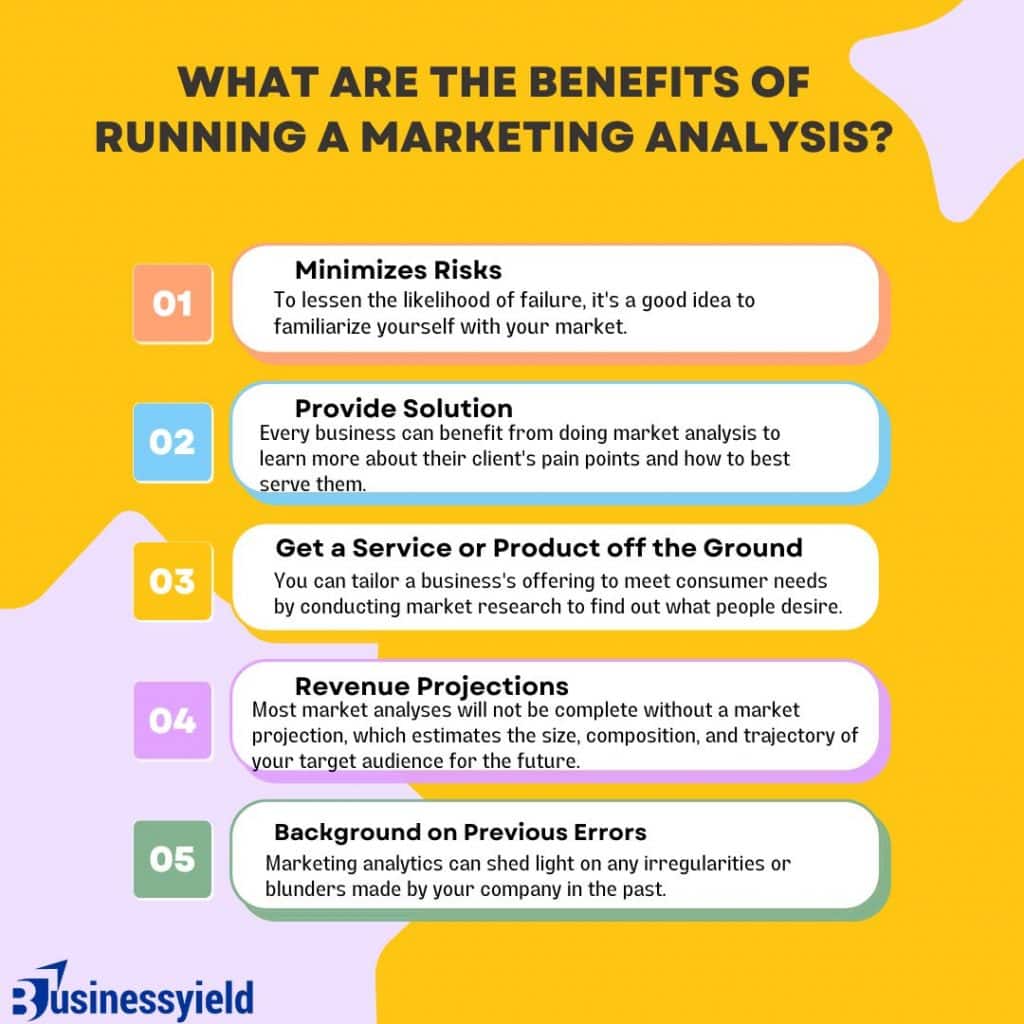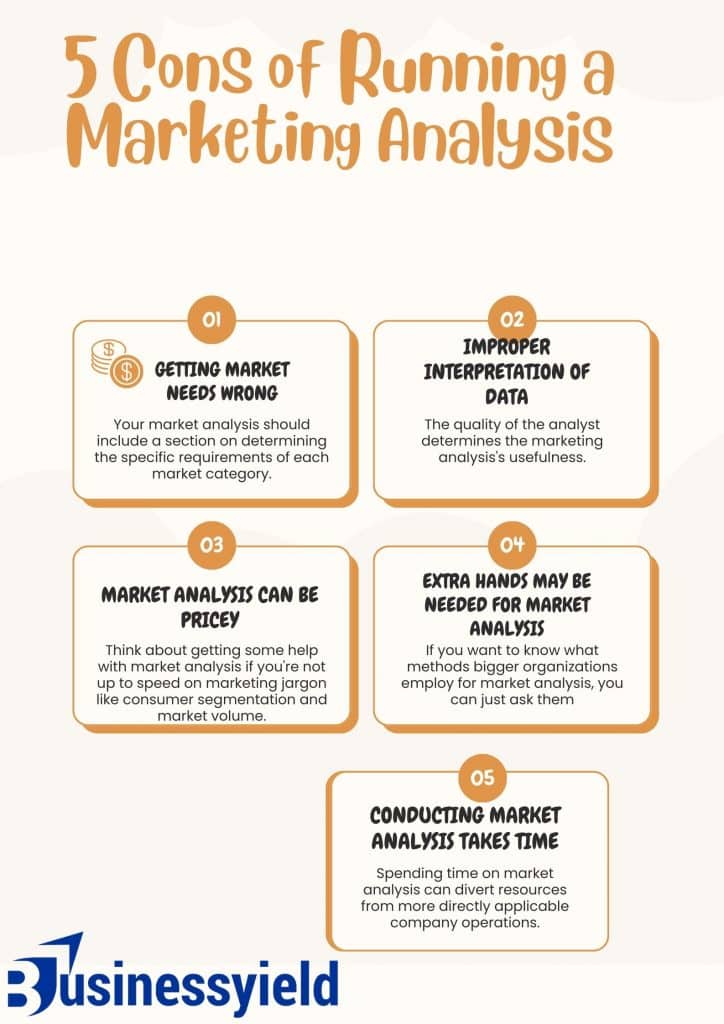While it can be unrealistic to expect to be able to glimpse into the future and discover a market willing to buy your product or service, savvy online store owners realize there are ways to test the waters and confirm their business ideas. One of those business planning steps is conducting a market analysis, and it’s critical for winning over the hearts and minds of potential customers in your target market. I’ll walk you through the market analysis process in this article, along with its benefits and drawbacks.
Key Points
- Companies conduct market analysis before introducing new products to determine their appeal to potential customers.
- Data resources to use for your market analysis include market size, personal characteristics, trends, location, personal traits, and behavioral patterns.
- The results of market analysis inform the final design of the product and determine how it will be positioned in the marketplace.
- Market analysis usually combines primary information, gathered directly from consumers, and secondary information, which is data available from external sources.
What is Market Analysis?
Market analysis ascertains the viability of a business or product through a quantitative and qualitative evaluation of a specific market.
This analysis compiles comprehensive data about a market, including its size and worth, consumers and their purchasing habits, and the players inside it. It is a great tool for gaining insight into a product, business, or sector, as well as for identifying its advantages and disadvantages, as well as potential threats and opportunities.
Different Methods of Market Analysis
To do a market analysis, accurate data is required. When it comes to conducting market research, small businesses often do it alone. In contrast, larger corporations frequently employ market research organizations to carry out this task on their behalf. There are several ways to gather information for a market analysis. Two types of research are differentiated: primary and secondary.
To gather fresh information, primary research involves interviewing market specialists. The main benefit is that your personal research goals remain front and center. You can get all the necessary information for your market analysis in this manner. This is in contrast to secondary research, which makes use of already-collected data from earlier polls.
There are two ways to gather this information: internally and externally. You can save time and money on expensive interviews and evaluations by using secondary research instead.
Examples of places you might find representative statistics include the Federal Statistical System, trade periodicals, company annual reports, and professional chambers.
Read: PRIMARY MARKET RESEARCH: Meaning, Methods, Examples, Comparison
How to Conduct a Market Analysis: Process
If you want to have a positive impact on your business, here are some guidelines I want you to adhere to:
#1. Define the Study’s Objective

First things first: figure out why you’re doing a market analysis. It could be for internal purposes, like enhancing cash flow or operations, or external purposes, like luring investors or getting a business loan. Some more reasons to conduct a market analysis include:
- Analyze potential new sites for expansion, such as more offices.
- Try out other services or goods
- Launch an exciting new company
- Cost estimates for research
- Think back on what has worked and what hasn’t
#2. Research Your Industry

Here, you’ll talk about the state of your industry and where you see it going. Size, trends, and anticipated growth are some of the most important industry data to consider.
Market research and analysis are distinct from industry research and analysis. Researching your industry entails surveying other companies in your field. Contrast this with market research, in which you seek to understand your target audience.
You demonstrate to investors that you have a firm grasp of the bigger picture by providing an overview of your industry. The most crucial thing is that it tells you how competitive the sector is likely to be and whether product demand will increase in the future.
Someone in the cell phone industry, for example, can do well to keep tabs on whether demand is on the rise or down. If you want to run a restaurant, you need to be aware of the overall trends in eating out. Is eating at restaurants becoming increasingly common? Conversely, can food delivery services lead to a shrinking market?
If you happen to be in the United States, visit the U.S. Census for some excellent industry statistics. Also, I’ve found Statista to be useful. Further, look into the trade group for your sector; they should be able to provide you with a wealth of information regarding developments in your area.
#3. Choose Your Ideal Customer

A good market analysis will include information about your target market. Write down what your dream customer is like in this section.
When you conduct your research, you will discover that there are many distinct styles of consumers. Market segmentation refers to the practice of dividing potential buyers into several groups based on their characteristics. Here, you can categorize your customers into parts based on their shared characteristics and define what makes each part unique.
Start with a high level of generality and narrow your focus by establishing the following components as you conduct your investigation:
Market Size
Market size refers to the number of people that could buy your product or service, as opposed to the monetary value of your sector.
Personal Characteristics
Give some demographic information about your average consumer, such as their age, gender, level of education, income, and more. Here, you can describe your ideal client in detail if you could paint a picture.
Location
Which regions serve as your target audience? Identify the nation, area, state, city, or county in question. Perhaps you’ll discover that your clientele is geographically divided, which will shed light on your future company ventures.
Personality Traits
Here is where understanding your client’s wants, desires, and reactions is crucial. Can you tell me what your clients enjoy and don’t like? How does their daily life unfold? Who are they as a person?
If you want to know how to analyze the competition better, this article can teach you that, too.
Behavioral Patterns
What you have here is an expansion of your psychographic data. Explain how your customers shop for and purchase products like yours.
Trends
The way customers act is dynamic and ever-changing. In this section, you should describe any patterns you’ve seen in your target audience.
#4. Study Competitor Businesses

Create a list of your firm’s competitors. Study each one to find out what you do well, what they could improve upon, and whether they represent any threat to your company. Learn about their products and services, where they are located, and any market advantages or disadvantages, so you can tailor your offerings to meet their needs and win their favor. If a landscaping business sees that its rivals don’t employ green energy gear, it might differentiate itself by offering battery-operated tools and appealing to eco-conscious clients.
Either you or a competitor analysis plan can conduct the necessary research on your competitors. Find out what you need by researching both free and paid products. The ability to compare website traffic and performance is one feature that many of these products have in common. As part of your market analysis, make note of the kind of clients that a company’s rivals are drawing in.
Read also: COMPETITOR ANALYSIS TOOL: Top 11+ Competitor Analysis Tools
#5. Gather Additional Data
The availability of more data allows the organization to acquire greater insights from its market analysis, which in turn comprises useful, factual, and unbiased data. Think about sending an email or creating a web survey to your present clientele to find out how happy they are with the price, service, quality, and convenience. You can also inquire about their thoughts on the organization’s referral program, their experience with the company overall, or any promotional materials they may have received. To collect this kind of data, bigger companies might conduct focus groups with their target demographics.
When doing market analysis, be careful to account for any constraints or rules imposed by the government. These resources have a wealth of information:
- State and local commerce websites
- Trade journal articles
- Target market surveys or questionnaires
- The U.S. Bureau of Labor Statistics (BLS)
- The Census Bureau
#6. Evaluate What You Find
Once you have gathered and confirmed all the relevant information, the next step is to evaluate it so you can put it to good use. If possible, divide your research into areas according to your purpose, target market, and competitors, as well as any other sections that make sense to you.
Your research should primarily consist of the following:
- An industry outlook
- Customer buying trends
- Your forecasted growth
- How much customers are willing to pay for your product or service
- An overview of your industry’s size and growth rate
- Your business’s projected market share percentage
#7. Take Action
The next step, after developing a market analysis, is to put it into action. Inside your company, try to figure out how you can apply your discoveries and research to make things better. Have you noticed any practices at other companies that you think your own company could benefit from? Is there room for improvement in the way you promote your products?
To make sharing your findings with lenders easier, compile all of your research and data into an easily consumable paper if you performed your analysis for purposes outside of your organization.
Make sure you keep track of all your research and information for your next analysis. It could be helpful to set a calendar reminder each year to stay updated with your market.
What Are the Benefits of Running a Marketing Analysis?

To better anticipate income, spot new trends, and lessen the likelihood of negative outcomes, marketing analysis is a useful tool. Doing a marketing study at regular intervals will help you stay abreast of any significant shifts in the market, and it can be useful at various points in your company’s lifecycle.
A thorough market analysis is an essential component of any good business plan because it allows you to better understand your target demographic and competitors. With this information, you can craft a marketing plan that is more specific to your market.
A market analysis also has the following additional benefits:
#1. Minimizes Risks
To lessen the likelihood of failure, it’s a good idea to familiarize yourself with your market. This will help you make more informed business decisions based on your knowledge of the industry’s key players, current trends, and what it takes to succeed. Also, you can take your company’s security to the next level by doing a SWOT analysis, which will help you identify your company’s advantages, disadvantages, opportunities, and threats.
#2. Provide Solution
Every business can benefit from doing market analysis to learn more about their client’s pain points and how to best serve them. If a plumbing business operates in a cold climate, for instance, they might find that older homes have more clogged drains than newer ones. This could be because of the cold weather and the age of the infrastructure in these homes. To avoid freezing in the winter, the plumbing company can promote the installation of a bigger discharge line once it becomes aware of the issue.
#3. Get a Service or Product off the Ground
You can tailor a business’s offering to meet consumer needs by conducting market research to find out what people desire. A painting business, for instance, might find that more people are interested in interior painting than outdoor painting. Advertisements and service bundles can be purposefully targeted using this data.
#4. Revenue Projections
Most market analyses will not be complete without a market projection, which estimates the size, composition, and trajectory of your target audience for the future. This can help you gauge your potential earnings and make any adjustments to your company’s strategy and financial plan.
#5. Background on Previous Errors
Marketing analytics can shed light on any irregularities or blunders made by your company in the past. For instance, thorough analytics can shed light on the factors that affect a product’s sales or the reasons for a metric’s performance. Because you will have a clearer picture of what went wrong and why, you will be better equipped to learn from your mistakes and prevent repeating them.
What Are the Cons of Running a Marketing Analysis?

A market analysis looks at the market as a whole to see where your product or service could fit in. Your small firm can benefit from this when making strategic choices. There are benefits to doing a market analysis, but here are some of its disadvantages that I will also want you to keep in mind:
#1. Getting Market Needs Wrong
Your market analysis should include a section on determining the specific requirements of each market category. Additionally, it highlights additional companies and goods that are making an effort to cater to this specific market group. Doing this has two major drawbacks. If you think your competitors are doing a great job of satisfying consumers’ requirements, you could give up on marketing altogether. It is also possible for you to mistake one fulfilled need for another. Your gift is special, so don’t undervalue it. Competitors may have the same target market as you, but that doesn’t imply you’re meeting the same demand.
#2. Improper Interpretation of Data
The quality of the analyst determines the marketing analysis’s usefulness. It is critical to appropriately evaluate the data collected from market surveys, even if you can get a lot of data. If you base your decisions on a misunderstanding of the facts, you will be severely handicapped. Get two or three reliable advisors to look over your findings. This analysis must not be based on wishful thinking.
#3. Market Analysis Can Be Pricey
Think about getting some help with market analysis if you’re not up to speed on marketing jargon like consumer segmentation and market volume. The quality of your analysis can improve, but your budget can take a serious hit if you do this. To keep expenses down, you should limit your market analysis to a specific demographic, like your present clients.
#4. Extra Hands May Be Needed for Market Analysis
If you want to know what methods bigger organizations employ for market analysis, you can just ask them. However, there are the standard expenses associated with employing a new employee that come with this activity. The next question is whether you do your market analysis, employ someone else, or outsource it. On many occasions, the more costly choices can provide more significant findings.
#5. Conducting Market Analysis Takes Time
Spending time on market analysis can divert resources from more directly applicable company operations. To make room in your day-to-day routine for analysis, you can focus on one topic at a time, such as purchasing habits or the competition.
Market Analysis vs. Market Research: What Are the Main Differences?
Given that market analysis is a subset of market research and that some market research projects can use it, the two fields share a great deal of common ground.
It is also possible to do research and analysis of the market in preparation for a company plan. Both of these strategies are packed with insights and can be used to back up a variety of reports and documents. Both of these can help you determine what to do next by analyzing the facts you gather.
But you shouldn’t mix the two names up because they mean different things.
Market research is more focused on collecting intelligence particular to customers, which is the fundamental difference between the two. In contrast, market research aims for a far broader view of a market, using more resources to carry out all potential business predictions and investigate all growth possibilities.
Market research is highly targeted and detailed, in contrast to more generalized market analysis. As a result, study populations, feelings, time, and other forms of human contact are limitations on market research.
When doing market analysis, as opposed to market research, it is necessary to deposit massive amounts of data into a massive storage framework. Gathering the precise information needed to address research questions is the backbone of market research.
Given the rapidity with which public opinion can shift, the findings of market research often have a validity period ranging from a few months to years (depending on the study’s population and theme), in contrast to the long-term effects of market analysis.
Ultimately, market research aims to comprehend the clientele and potential future customers of a market, whereas market analysis attempts to paint a picture of the market as a whole.
Market Analysis Checklist
To help you with your market analysis, I have put together an extensive checklist and outlined the steps below.
BusinessYield Market Analysis Checklist
What Do You Mean by Market Area Analysis?
This process entails collecting and evaluating data to gain insights into the market’s size, growth prospects, target demographic, and competitive environment. Businesses can benefit from conducting market analyses in three ways: decision-making, opportunity identification, and marketing strategy development.
Bottom Line
In conclusion, a market analysis is a great tool for businesses looking to learn more about a specific market. It can assist you in identifying and assessing the opportunities and hazards of a market, which is useful whether you are starting a business, researching your present market, or just looking at potential new markets. You can put your business plan into action and create tangible marketing tactics by conducting a market analysis.
Similar Articles
- COMPETITOR WEBSITE ANALYSIS: Top 10+ Web Analytic Free Tools in 2023
- What Is Pricing? Understanding Pricing In The Marketing Mix
- COMPETITOR INTELLIGENCE: Definition, Examples & Uses






